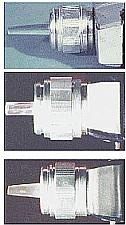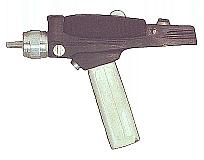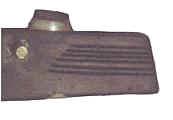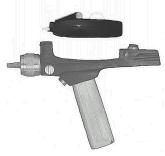The First Phasers
Page 3
 These
muzzles are one of the most complex parts of the phasers and they appear to
have been made at about the same time and possible by the same man and/or shop.
I expect that they went ahead and did a large run of these muzzles at the time
ensuring the show would have many spares to harvest for later use .
These
muzzles are one of the most complex parts of the phasers and they appear to
have been made at about the same time and possible by the same man and/or shop.
I expect that they went ahead and did a large run of these muzzles at the time
ensuring the show would have many spares to harvest for later use .
This would also help explain how these black and white models are still around today,
since it is normal policy in Hollywood to refinish and repaint props, sets and everything,
as needed. Having spares of some of the most difficult and costly parts to make would
allow them to easily build new replacement props.
Another reason they may have chosen to replace rather than refinish could be that they
had to carry on with the filming of the shows and had to use what was already on hand.
When the new models arrived, these old black and white ones could have been simply put
into storage.
Or perhaps the models were lost before they could be repainted and refinished. This is
unlikely for if losses were to be the saving factor, then only a few would have survived
and the rest would have been repainted and refinished. The few that did "escape"
would be a lot rarer today. But we do seem to have the full accounting of most of the
black and white phasers for, by noting small details, we believe that we have been able to
match and count these models from show to show and then, from the show to the hands of
collectors.
Either way, the fans are the benefactors as this model of phaser did indeed survive to
this day and everyone can enjoy them, check them out and study these pieces of Star Trek
history.
 One of the first models I held and photographed may even have the grand-daddy
of them all, for, unlike the majority of the models, this one was made out of
wood. Almost all of the other standard models appear to have been cast out of
fiberglass. There was a corner on the handle where you could see that the paint
was worn away from the edge and what was underneath seemed to be wood. When
I held this model in my hand it also felt like wood. I did not probe it as I
did not wish to mar it, so I can only relate what I saw and what the owner said.
Also, there were a set of lines cut into the rear section, deep fine lines.
These lines were cut into the body at the same place that on later models you
would see either a lowered area painted silver or a set of four aluminum fins.
Again, these were clean straight cuts, the kind you could only make in a soft
material like wood.
One of the first models I held and photographed may even have the grand-daddy
of them all, for, unlike the majority of the models, this one was made out of
wood. Almost all of the other standard models appear to have been cast out of
fiberglass. There was a corner on the handle where you could see that the paint
was worn away from the edge and what was underneath seemed to be wood. When
I held this model in my hand it also felt like wood. I did not probe it as I
did not wish to mar it, so I can only relate what I saw and what the owner said.
Also, there were a set of lines cut into the rear section, deep fine lines.
These lines were cut into the body at the same place that on later models you
would see either a lowered area painted silver or a set of four aluminum fins.
Again, these were clean straight cuts, the kind you could only make in a soft
material like wood.

 Continuing on our tour of the phaser, from the muzzle moving up and over
the top you come on to the metal top cap just in front of the smaller phaser
one. This is one of the only parts that seem to be the same on all pistol phasers.
You can see them shiny and silver on each and every phaser.
Continuing on our tour of the phaser, from the muzzle moving up and over
the top you come on to the metal top cap just in front of the smaller phaser
one. This is one of the only parts that seem to be the same on all pistol phasers.
You can see them shiny and silver on each and every phaser.
 There
is a belief that the one and two phaser combo were in fact planned to be a part
of an even larger weapon's system. The phaser one was able to plug into the
pistol body. This resulting pistol body was intended to plug into a rifle stock
to make a phaser rifle. There may have been a plan to fit a longer barrel onto
the front of the pistol or it might have been part of the rifle stock. This
styling and design idea was later used in the show "V"
where the pistol fit into a shoulder stock, had a barrel extension added and
a scope mounted upon the top to make a mean looking assault rifle. Yet, this
was never done in Star Trek. The phaser rifle from the second pilot "Where
No Man Has Gone Before" was a stand-alone and used only in this one show,
never to be seen again.
There
is a belief that the one and two phaser combo were in fact planned to be a part
of an even larger weapon's system. The phaser one was able to plug into the
pistol body. This resulting pistol body was intended to plug into a rifle stock
to make a phaser rifle. There may have been a plan to fit a longer barrel onto
the front of the pistol or it might have been part of the rifle stock. This
styling and design idea was later used in the show "V"
where the pistol fit into a shoulder stock, had a barrel extension added and
a scope mounted upon the top to make a mean looking assault rifle. Yet, this
was never done in Star Trek. The phaser rifle from the second pilot "Where
No Man Has Gone Before" was a stand-alone and used only in this one show,
never to be seen again.
The pistol body would give the little phaser one more power, more range and control
through the larger beam control muzzle and longer firing time due to the larger power
pack. The phaser pistol body was like the "Linear
amplifier" currently used by radio
operators to boost a low power radio by feeding its low powered output into a special
amplifier made to handle a smaller amp output and then increase this input to a much
greater and higher amplified output.









